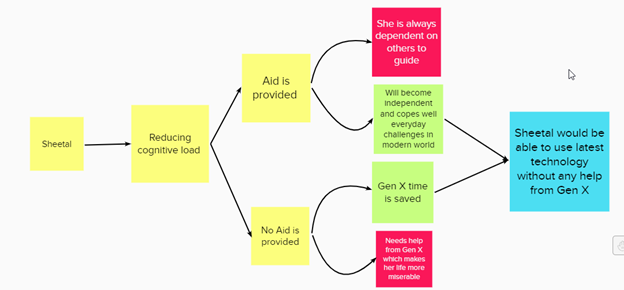By technovators | 2022-02-22
This is a guest post written by a team of enthusiastic people who got together for a Design Thinking workshop and worked on helping an octagenarian to remember better. You can read the list of team members in the author description. This case study is complete with a working prototype (Scroll to the end to interact with an embedded prototype of an app). Thanks Lakshay and team for your active contributions to the Karmic Design Thinking repository ❤.
Download the entire case as a PDF.
- Project Name
- Agewell
- Team Name
- Technovators
Project Summary: A voice based interactive app/device which could help elderly people (above the age of 80 years) to recollect their short term memory and identify people, objects, places that surround them. Along with it, the system would predict your next actions basis user study and suggest or motivate the ways it could be better achieved with less cognitive load and lower muscle drudgery.
Empathize
Persona

An 83 years old lady, named Sheetal who lives with her whole family comprising of her husband, children and grandchildren as well in the town – Mandsaur, Madhya Pradesh, India. She is a homemaker and likes to do day-to-day homely task on her own.
She faces challenges in retaining information for long-term. Along with the aging she faces problem of holding objects firmly because of lower bone density. Diminishing eye-sight is another pain area for her.
Customer Journey Map



Note - Smileys and Sadeys represent the emotional state
List of Problems/how might we questions
- How might we help her in remembering things, names, and plans?
- How might we help her in reducing constant knee, back and muscle pain while performing daily activities?
Analyze
Multi-Why
Performing Multi-Why Analysis to analyze the unearthed pain areas and reframe the “HMW” questions?

Conflict of Interest
Identification of Conflict-of-interests between multiple participating entities in the whole workflow. Identifying the secondary user was challenge here.

Solve
Moving to the third stage, after Empathize and Analyze, came the “Solve”. Ideation Session happened through Controlled brainstorming. Most voted ideas were picked up for further nurturing.
Ultimately, the solution which was envisaged was. “A ML based app/wearable device which will be powered by voice based interaction (with no essential need of real-time face time with the interface). The app will function by taking independent variables like the environment around the user, their day-to-day activities, their medicines, their pain areas, and also keep an account of their near-and-dear ones. Then it will predict or let us say, identify the person, object, place that come in touch with the user. The app would also keep the note of day-to-day activities of the user and suggest the better way to day it in the most human centric and ergonomic format.
Advantages to the users:
- Become Independent
- Have a friend to guide
- Cost effective
Test
Lastly, came the “Make-Test” phase. High-fidelity prototype was made using tool like Adobe Xd and integration with Google ML based API which identifies person or object in front of a camera was demonstrated.
The ideas were demonstrated to the entire cohort and feedbacks were very well taken for the next iteration of changes and launch.
Link to prototype: https://xd.adobe.com/view/dc99d3db-a207-4b6c-9c6f-8465ffd46b3f-89ca/
ML Based API: https://teachablemachine.withgoogle.com/models/S9bzKmbM7/






